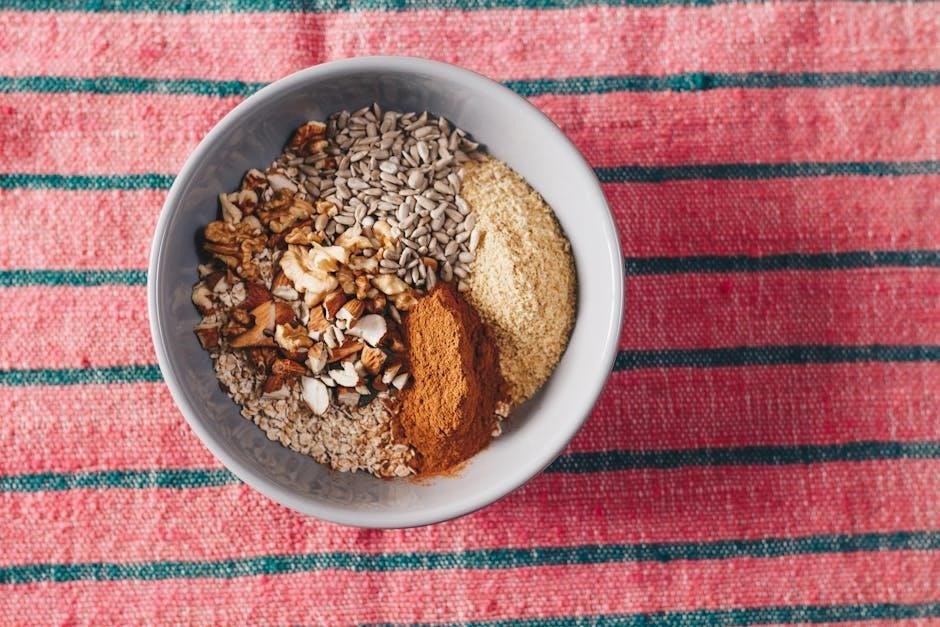anti reflux diet pdf
An anti-reflux diet focuses on managing acid reflux symptoms by avoiding trigger foods and incorporating alkaline options. It emphasizes dietary changes to reduce esophageal irritation and improve digestion naturally.
Understanding GERD and Its Impact on Health
Gastroesophageal reflux disease (GERD) is a chronic condition where stomach acid frequently flows back into the esophagus, causing irritation and discomfort. Common symptoms include heartburn, regurgitation, and difficulty swallowing. If left unmanaged, GERD can lead to complications like esophagitis, strictures, or Barrett’s esophagus, which increases the risk of esophageal cancer. The condition significantly impacts quality of life, disrupting daily activities and sleep. Understanding GERD’s underlying causes, such as a weakened lower esophageal sphincter or obesity, is crucial for effective management. Lifestyle and dietary changes play a central role in alleviating symptoms and preventing long-term health issues. Adopting an anti-reflux diet is often the first step in managing GERD, helping to reduce acid production and minimize esophageal irritation. This approach, combined with other lifestyle modifications, can significantly improve overall well-being and prevent complications.
Why Dietary Changes Are Essential for Managing Acid Reflux
Dietary changes are crucial in managing acid reflux as they directly impact stomach acid production and esophageal irritation. Certain foods and beverages, such as citrus fruits, tomatoes, chocolate, caffeine, and alcohol, can trigger reflux by relaxing the lower esophageal sphincter or increasing stomach acid. By identifying and avoiding these trigger foods, individuals can significantly reduce symptoms. Additionally, incorporating alkaline and low-acid foods like vegetables, lean proteins, and whole grains helps neutralize stomach acid and promote a healthier digestive environment. Portion control and eating habits, such as avoiding late-night meals and overeating, also play a vital role in preventing reflux episodes. These dietary adjustments not only alleviate symptoms but also support long-term digestive health, making them a cornerstone of acid reflux management.

Key Principles of the Anti-Reflux Diet
The anti-reflux diet focuses on avoiding trigger foods, incorporating alkaline options, and practicing portion control to reduce acid production and alleviate symptoms effectively.
Foods to Avoid: Triggers of Acid Reflux
Certain foods can trigger acid reflux by relaxing the lower esophageal sphincter or increasing stomach acid production. Common culprits include citrus fruits, tomatoes, chocolate, caffeine, alcohol, and spicy or fatty foods. Processed and fried foods, as well as sodas and carbonated beverages, can also exacerbate symptoms. These foods often delay digestion, putting pressure on the stomach and esophagus. Additionally, foods high in sugar or refined carbohydrates can contribute to inflammation and worsen reflux. Identifying and eliminating these triggers is a crucial step in managing symptoms effectively. By avoiding these foods, individuals can reduce irritation and promote a healthier digestive system.
Foods to Include: Alkaline and Low-Acid Options
An anti-reflux diet emphasizes the inclusion of alkaline and low-acid foods to help neutralize stomach acid and reduce irritation. Leafy greens like spinach, kale, and lettuce are excellent choices due to their alkaline properties. Non-citrus fruits such as bananas, melons, and berries are also beneficial, as they are less likely to trigger reflux. Lean proteins like poultry, fish, and tofu are recommended, as they are easier to digest and don’t relax the lower esophageal sphincter. Whole grains, including oatmeal, brown rice, and quinoa, are also ideal for their mild acidity and high fiber content. Incorporating these foods into meals helps balance the diet and alleviate symptoms. By focusing on these options, individuals can create a meal plan that promotes digestive health and reduces acid reflux episodes effectively.
Portion Control and Eating Habits
Portion control and mindful eating habits play a crucial role in managing acid reflux symptoms. Eating smaller, more balanced meals throughout the day can reduce pressure on the lower esophageal sphincter (LES), minimizing the risk of acid backflow. It’s important to avoid overeating and to chew food thoroughly to ensure proper digestion. Additionally, refraining from eating at least 2-3 hours before lying down can help prevent nighttime reflux. Avoiding late-night meals and snacks is particularly beneficial, as lying down immediately after eating can exacerbate symptoms. By adopting these habits, individuals can better control their acid reflux and promote a healthier digestive system. Regular, balanced meals and mindful eating practices are essential components of an effective anti-reflux diet.

Specific Dietary Recommendations
Focus on avoiding trigger foods like citrus, tomatoes, chocolate, and fatty foods. Incorporate alkaline-rich options such as vegetables, lean proteins, and whole grains. Adjust meal timing and frequency to alleviate symptoms and optimize digestion.
Trigger Foods: Identifying and Eliminating Common Culprits
Identifying and eliminating trigger foods is crucial for managing acid reflux. Common culprits include citrus fruits, tomatoes, chocolate, caffeine, alcohol, spicy dishes, and fatty or fried foods.
Alkaline Foods: How They Help Reduce Reflux Symptoms
Alkaline foods play a significant role in reducing acid reflux symptoms by neutralizing stomach acid. Incorporating vegetables like spinach, broccoli, and green beans, along with lean proteins and whole grains, helps balance acidity. These foods promote a less acidic environment, easing irritation and discomfort. Regular consumption can lead to symptom relief and improved digestion. Additionally, staying hydrated with alkaline-rich beverages supports overall digestive health. By focusing on these options, individuals can create a diet that naturally alleviates reflux issues and enhances well-being. This approach aligns with the anti-reflux diet’s goal of managing symptoms through dietary adjustments. Thus, alkaline foods are a cornerstone of effective acid reflux management.
Meal Timing and Frequency: Strategies for Symptom Relief
Eating smaller, more frequent meals throughout the day can help manage acid reflux symptoms by reducing stomach pressure and acid production. Avoiding large meals, especially close to bedtime, is crucial, as lying down after eating exacerbates reflux. It is recommended to finish meals at least 2-3 hours before lying down or sleeping. Additionally, spacing meals evenly can prevent overloading the stomach, which may trigger reflux episodes. Drinking water between meals instead of during can also aid digestion without putting extra pressure on the lower esophageal sphincter. Avoiding late-night snacks and adhering to a consistent eating schedule can further alleviate symptoms. By adjusting meal timing and frequency, individuals can significantly reduce discomfort and improve overall digestive health. Consistent implementation of these strategies is key to long-term symptom relief.

Lifestyle Changes to Complement the Diet
Adopting a healthy lifestyle, including regular exercise, stress management, and avoiding tight clothing, can enhance the effectiveness of the anti-reflux diet in reducing symptoms and improving overall well-being.
Weight Management: How Excess Weight Affects Reflux
Excess weight, particularly around the abdominal area, can significantly worsen acid reflux symptoms. It increases intra-abdominal pressure, pushing stomach contents upward and causing the lower esophageal sphincter to relax. This leads to more frequent acid reflux episodes. Additionally, obesity is linked to inflammation and metabolic changes that exacerbate reflux. Losing even a small amount of weight can alleviate symptoms by reducing pressure on the stomach and improving sphincter function. A healthy, balanced diet combined with regular physical activity is essential for sustainable weight management. It’s important to aim for gradual weight loss to avoid rapid changes that might temporarily worsen reflux. Consulting a healthcare provider or dietitian can help create a personalized plan to address both weight and reflux effectively.
Posture and Physical Activity: Reducing Symptom Triggers
Maintaining proper posture and incorporating appropriate physical activity can significantly reduce acid reflux symptoms. Avoiding bending over or lying down immediately after meals is crucial, as these positions can push stomach contents back into the esophagus. Sitting upright or taking a short walk after eating can help prevent reflux episodes. Additionally, regular moderate exercise, such as walking or yoga, strengthens core muscles and improves digestion. However, high-intensity workouts or exercises that involve bending or jarring movements should be avoided, especially after meals. Ensuring good posture during meals and avoiding tight clothing that presses on the abdomen can also alleviate symptoms. By combining mindful movement with dietary adjustments, individuals can effectively manage reflux triggers and improve overall comfort.

Monitoring and Adjusting the Diet
Regularly tracking symptoms and food intake helps identify triggers and refine dietary choices. Adjustments may involve adding or removing specific foods to optimize symptom relief and digestive health.
Keeping a Food Diary: Tracking Symptoms and Progress
Keeping a food diary is a powerful tool for managing acid reflux. By documenting meals, portion sizes, and symptoms, individuals can identify specific triggers and monitor progress. This diary should include details like meal times, food types, and symptom severity. Over time, patterns emerge, helping refine dietary choices. For instance, noting post-meal heartburn or bloating can reveal problematic foods. Additionally, tracking symptom-free periods provides insights into beneficial habits. Regular reviews of the diary allow for adjustments, ensuring the diet remains effective. This practice fosters accountability and empowers individuals to take control of their condition. By maintaining a food diary, patients can collaborate more effectively with healthcare providers, tailoring their anti-reflux plan for optimal results. Consistent tracking leads to better symptom management and improved overall health outcomes.
Consulting a Healthcare Provider: When and Why It’s Important
Consulting a healthcare provider is crucial for effectively managing acid reflux, especially if symptoms persist despite dietary changes. A provider can help tailor the anti-reflux diet to individual needs, ensuring it aligns with overall health goals; They can also rule out other conditions that may mimic reflux symptoms, such as stomach ulcers or gastroparesis. Additionally, healthcare professionals can recommend medications or therapies if lifestyle changes alone are insufficient. Regular check-ups allow for monitoring of symptom improvement and adjustments to the treatment plan. For those with severe reflux or complications like esophagitis, medical guidance is essential to prevent long-term damage. Collaborating with a provider ensures a comprehensive approach to managing reflux, combining dietary strategies with medical expertise for optimal results. This partnership is key to achieving lasting relief and improving quality of life.


